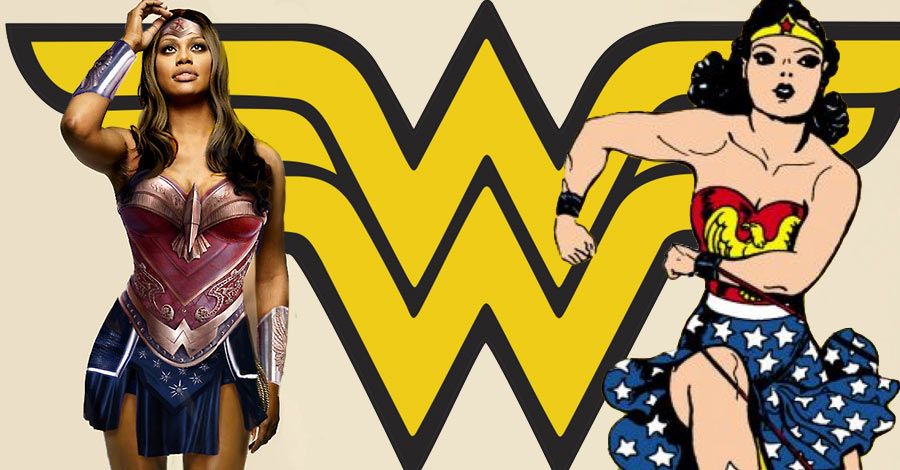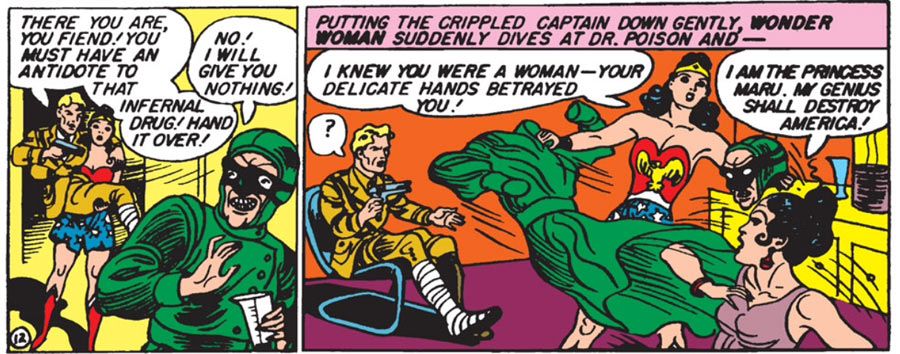So, who is the ideal person to play Wonder Woman?
The recently revealed image of Gal Gadot as a Xena-like Wonder Woman has sold a number of folks on her in the role, but artist seraphatonin has presented an unexpected but brilliant alternative: Laverne Cox ("Orange is the New Black"). The idea was first suggested by tumblr poster noottersontheflightdeck, and seraphtonin created a marvelous mash-up image of Cox in a classic version of the costume, looking transcendent, inspiring, strong and ready to take man's world on.
Seraphatonin isn't against Gal Gadot in the role, but as she explained to me, she loves the idea of Cox as Diana for a simple reason. "She represents so much of what Hollywood considers unmarketable -- she's black, she's trans, she's a woman... Part of what's always drawn me to Diana is her dedication to defending those who can't defend themselves, and that dedication could be so much more complex and personal if she herself experienced the sexism and racism she fights against."
RELATED: Warner Bros. Debuts First Photo of Gadot as Wonder Woman
Those are all great reasons to cast Cox as Diana, but here's another one: William Moulton Marston, Wonder Woman's creator, feminist, psychologist and crank, would probably love it.
Marston's been dead for six decades, so he can't speak for himself on this, and there is the unfortunate fact that, even by the ugly standards of his day, his comics could be very insensitive, or even racist. Still, I'd like to think he could have gotten beyond that, and there are other reasons to think he would have been enthusiastic about Cox picking up the golden lasso.
First among these is that the original "Wonder Woman" comics were full nigh-to-bursting with cross-dressing and gender swapping. "Sensation Comics" #2, one of the very first Wonder Woman stories, released in 1942, featured the evil Dr. Poison, a misshapen, green-garbed scientist. At the end of the issue, he is revealed to be a shapely woman -- who is swatted on the rear as punishment by Wonder Woman's burly sidekick, Etta Candy. Cross-dressing is not the same as trans identity, of course -- but in the context of a comic, where the characters aren't real people anyway, the symbolism is easy to blur. We don't know for sure, after all, whether Dr. Poison considers himself a man or a woman -- and indeed that ambiguity seems intentional on Marston's part. (Though he does seem to prefer to live as a man, so I've stuck with the male pronoun.)
This ambiguous gender identity would be a reoccurring theme in Marston's comics. In 1944, Wonder Woman encounters the mustachioed villain Hypnota -- only to discover that he's actually the twin sister of his hypnotized servant named (wait for it) Serva. Again, in "Sensation Comics" #46, from 1946, the Blue Snowman, who seems to have been created in collaboration with Marston's co-writer and assistant Joyce Murchison, pops off his blue cloud head for what is by now a familiar reversal, revealing himself to be a woman. Finally, in the last issue Marston wrote, "Wonder Woman" #28, published after his death, all three of his cross-dressing villains return. Wonder Woman knows who they all are, so there's no reason for disguises, but they still dress as men anyway. Because, why not?
Poison, Hypnota, and the Snowman are villains, and you could arguably see them as in line with such cross-dressing bad guys as Norman Bates in "Psycho" or Buffalo Bill in "Silence of the Lambs," characters whose psychotic impulses are tied to their gender identity. But Marston never links his characters' drag to their villainy. Dr. Poison isn't evil because he had some sort of traumatic relationship with his father; he just likes dressing up as a guy. Hypnota for his part explains that it was great fun for him to switch back and forth, pretending to be his twin sister one minute and the powerful male Hypnota the next. Or, as he says, "Ha! Ha! It was amusing to pose as Serva, hypnotize people and then escape by blaming it on myself!"
All of these characters are drag kings, or (arguably) trans men, but there is one important character who can be seen as a trans woman. Namely, Wonder Woman herself.
Within the narrative of the comic, of course, Wonder Woman is cis[gendered]. But Marston's vision of his creation's gender was complicated. In an article for "The American Scholar," he explained his purpose in creating the character:
"It seemed to me, from a psychological angle, that the comics' worst offense was their blood-curdling masculinity. A male hero, at best, lacks the qualities of maternal love and tenderness which are as essential to a normal child as the breath of life... It's smart to be strong. It's big to be generous. But it's sissified, according to exclusively masculine rules, to be tender, loving, affectionate, and alluring. 'Aw, that's girl stuff!' snorts our young comics reader. 'Who wants to be a girl?'
"And that's the point; not even girls want to girls so long as our feminine archetype lacks force, strength, power."
The phrasing here is telling; "not even girls want to be girls." The implication is that girls should want to be girls -- and that boys should want to be girls, too.
Marston finishes up his discussion by insisting that, if shown a strong enough woman, men will "be proud to become her willing slaves." According to Marston's idiosyncratic theories, women were superior to men because, as he said in a letter to his publisher, they "enjoy submission; enjoy being bound... The only hope for peace is to teach people who are full of pep and unbound force to enjoy being bound." So to save the world, women need to teach men how to submit, because women are better at submitting than men. And when men submit, they become like women. The whole point of Wonder Woman, from Marston's point of view, is to teach both men and women to be better women.
Obviously, there aren't many folks, whether feminists, non-feminists, cis, or trans, who would sign onto Marston's particular vision of femininity and submission and gender. But be that as it may, it should be clear at this point why Marston was so enthusiastic about cross-dressing in his comics. The sequence in "Wonder Woman" #23, where the evil cat-headed alien guys riding giant kangaroos invade Paradise Island, only to reveal that under the cat heads they're women, ready to do good and join the Amazons -- that's Marston's utopian vision, right there on the comics page. Men turn into women and bliss prevails. Men, women, cat-headed aliens -- everyone, everywhere, will become, through Wonder Woman's tutelage, a sister and an Amazon.
"In a world where masculinity is respected and femininity is regularly dismissed, it takes an enormous amount of strength and confidence for any person, whether female- or male-bodied, to embrace their feminine self," Julia Serano, a trans activist and gender theorist, wrote in her book "Whipping Girl." Marston would have agreed with that. And I think he also would have seen Wonder Woman as an expression of his own feminine self; the strong, powerful woman he wanted to be, and wanted everyone, boys and girls, to be as well. Who better to embody that dream than Laverne Cox? Who better to fight for everyone's femininity than a woman like Cox who has fought for, and won, her own?
Noah Berlatsky is the editor of the comics and culture site the Hooded Utilitarian. (www.hoodedutilitarian.com) His book "Wonder Woman: Bondage and Feminism in the Marston/Peter Comics," will be out in early 2015.


